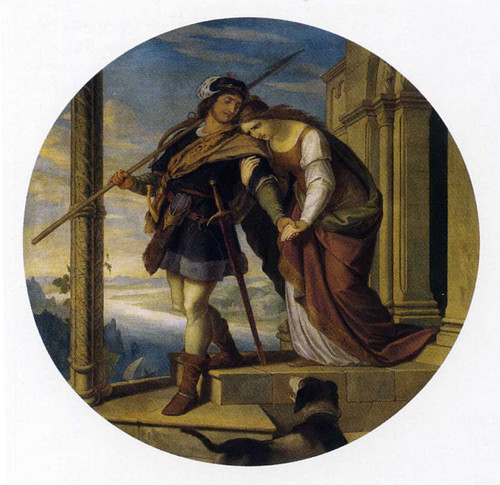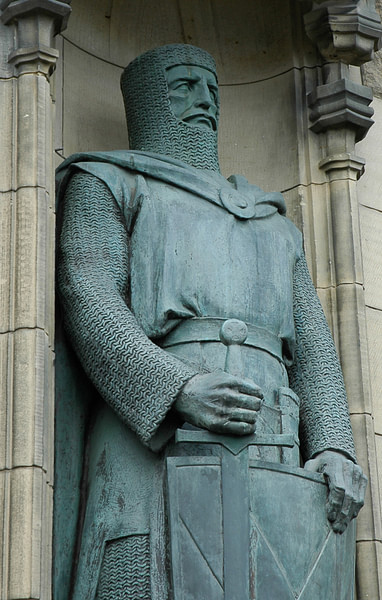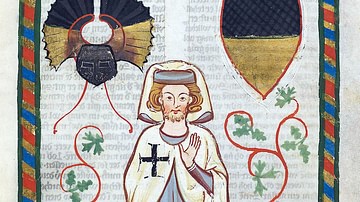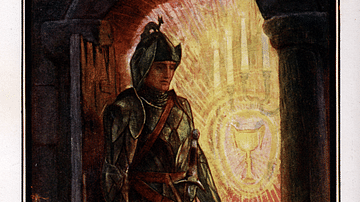The knights of medieval Europe were meant to be the finest fighting men of their age, even more important, they were expected to be pure in thought and deed, as exemplified in the chivalrous code which they (usually) followed. Here are the stories of 12 such knights. The legendary figures are perhaps based on historical knights and the historical knights have all become legendary; such is the indistinct line of truth between fact and fiction and humanity's need to create larger-than-life figures of a by-gone age when valour and chivalry reached their apex.
Legendary Knights
Saint George
The Eastern Orthodox Saint George became the patron saint of all knights and so, even if strictly speaking he was not a medieval knight himself, he must appear first in this list. This legendary figure, based on a soldier in the Roman army who was martyred in 303 CE in Lydda (modern Lod, Israel) for his Christian beliefs, became the example to follow of all chivalrous knights in the medieval period. By the 8th century CE Saint George's legend had reached Europe, and by the 12th century CE his story was well-established; he famously rode his white horse, Bayard, into battle against a dragon which was tormenting the people of Libya, the slaying of the creature becoming a lasting metaphor for good against evil, Christians against non-believers. In the process, George saved a princess offered to the dragon as a sacrifice, and her rescue became a symbol for the protection of Innocence.
According to some legends, George had a mighty sword called Ascalon, made by the Cyclops of ancient Greece, and a shining suit of armour made from Libyan steel. In the late 12th century CE, Richard I (see below) decided to use the red cross on a white background of Saint George's banner on the liveries of English soldiers. The story of Saint George was further popularised by the c. 1260 CE The Golden Legend by the Italian chronicler Jacobus de Voragine. The saint thus became, and still remains, a popular figure all over Europe: the first ever secular knight's order was dedicated to him in Hungary in 1326 CE, he is the patron saint of many countries including England, Greece, and Russia, and the patron of several major cities, including Moscow and Beirut.
Sir Galahad
The King Arthur legends captured in several 12-15th century CE literary works provided stirring stories of example for all knights to follow, and several of the knights of the Round Table might have made this list. Sir Lancelot was a great knight but, if chivalry is an essential part of knighthood, then his infidelity with Guinevere and betrayal of King Arthur precludes him. His son, Galahad, though, is often cited as the most perfect knight of all. With a lineage supposedly stretching back to King David of Bible fame, his mother was Elaine, daughter of Pelles, the crippled Fisher King and keeper of the Holy Grail (Christ's cup at the Last Supper).
Galahad arrived one day at Camelot and convinced King Arthur that he was the chosen one to find the Grail first by safely sitting in the Siege Perilous, the magical empty chair of the Round Table which was said to be deadly for all but he who would find the Grail, and second by withdrawing the fabled sword from the stone. Now made a knight, Sir Galahad's weapons were said to have been the spear which had pierced Jesus Christ at the Crucifixion and the sword of King David. His white shield was marked with a cross drawn with the blood of Joseph of Arimathea (he who had brought the Grail to Europe). Sir Galahad was, besides being a brilliant jouster who defeated all comers (except his father), humble, innocent, and pure. Indeed, Sir Galahad was the only knight considered worthy of pursuing and finding the Grail, which is perhaps an allegory of the Christian path to salvation. Sir Galahad finally found the grail, or at least caught sight of it, at the castle of the Fisher King, after which the knight rose to Heaven in some versions, or embarked on an odyssey in the Holy Lands in others, where he again found the Grail and this time took it with him into the next life.
Siegfried
Siegfried is a legendary German knight and prince who appears as the hero of the c. 1200 CE German epic poem the Nibelungenlied. More myth than reality, the figure is based on older Germanic and Norse folklore, but he may originally have been inspired by a Frankish knight of the 7th century CE or even a Germanic leader who fought valiantly against the Romans in the 1st century CE. Just like Saint George, Siegfried appears as a sanitised and chivalrous version of earlier legendary figures and, like George, too, he successfully dealt with a bothersome dragon. The hero bathed in the dead creature's blood and thus became immune to weapons except on one small patch of his back where a leaf had stuck.
The German knight's greatest challenge was, though, to win the hand of Kriemhild, a Burgundian (Nibelung) princess. After a dream which indicated any future husband would meet a violent death, the princess resolved not to bother with matrimony. She remained unimpressed with Siegfried's record of captured riches, dragon-slaying and victories over the Danes and Saxons when fighting for the Burgundian army. Meanwhile, the Burgundian king, Gunther, had fallen in love himself, with a beautiful queen called Brunhilde who would only marry the suitor who could defeat her in battle, and so he made a deal with Siegfried. The latter would, after being magically made invisible, fight the queen and the king would take both the credit and the queen. In return, Siegfried could marry Kriemhild. So it came to pass until a falling out between the two ladies led to Kriemhild revealing the trick played on Brunhilde. The king was outraged, and one of his retainers, Hagen, on discovering the hero's one weak spot, killed Siegfried on a hunting trip. Hagen got his comeuppance, though, when Kriemhild killed him with Siegfried's sword.
Historical Knights
Robert Guiscard - 'The Crafty'
Robert Guiscard (c. 1015-1085 CE) was a Norman knight who fought with success against the Byzantine and Arab Empires from 1057 CE to create his own duchy in southern Italy and Sicily. Robert's territorial claims were endorsed by the papacy in 1059 CE which recognised his title of the Duke of Apulia, Calabria, and Sicily. He extended his control of Italy when he captured Bari in 1071 CE after a three-year siege, Palermo in 1072 CE and Salerno in 1076 CE. Still not satisfied, Robert grabbed Corfu in 1081 CE and shortly after defeated an army led by the Byzantine emperor Alexios I Komnenos (r. 1081-1118 CE) at Dyracchion, Dalmatia. 1084 CE saw Robert win a victory against a Venetian force, the powerful allies of the Byzantines. Ever ambitious, the Norman duke died on his way to attack the biggest prize of all, Constantinople, in 1085 CE, not in battle but from typhoid. His nickname of 'the Crafty' derives from his surname's relation to the Old French word viscart, meaning 'wily as a fox'. The Italian writer Dante Alighieri has Sir Robert as one of the great knights in his Divine Comedy (c. 1310 CE).
Rodrigo Díaz de Vivar - 'El Cid'
Rodrigo Díaz de Vivar (1043-1099 CE), better known as El Cid, from the Arabic assid, meaning 'lord', was a famed Spanish knight and general, so famous even his sword had a name: Tizona. He first came to prominence as a commander of the armies of King Ferdinand I of Castile and Leon (d. 1065 CE), a position he gained aged just 22. After a dispute with a rival commander in 1081 CE, El Cid was exiled and he then served the Moorish king al-Mu'tamin (1081-85 CE) at Zaragoza. A decade of victories against rival Moors and Spanish kings followed and he acquired another nickname, El Campeador ('The Champion').
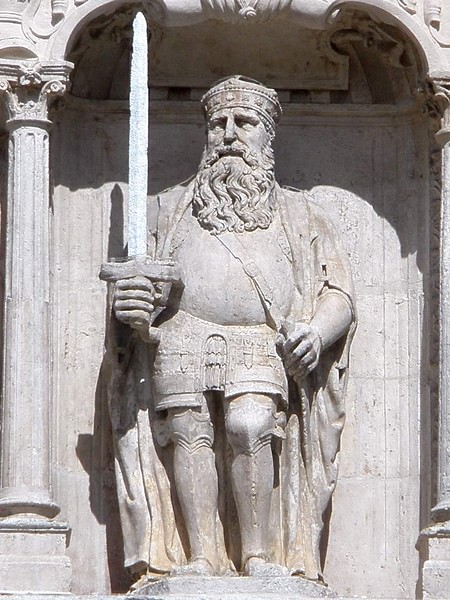
Deciding it would be more profitable to fight for himself, El Cid took Valencia in 1090 CE. In theory, he still represented the Spanish king Alfonso VI (r. 1077-1109 CE) but El Cid was now a ruler in his own right. The great general died in 1099 CE, but his body was paraded before his army to ward off an Arab attack, just as El Cid had been instructed to arrange by Saint Peter in a dream on his deathbed. The trick worked and Valencia withstood the onslaught, albeit temporarily, for later in the same year it did finally fall to the Muslim Almoravids. The great commander's body was buried at the monastery of San Pedro in Castile. El Cid was not just missed by his warriors but even his horse Bavieca who, according to legend, never let anyone else ride him after his master's demise. Following his death, El Cid's legend only grew, particularly fuelled by the 1142 CE epic poem Cantar del Mio Cid ('Song of the Cid').
Sir William Marshal - 'The Greatest Knight that Ever Lived'
Sir William Marshal (c. 1146-1219 CE) was a highly celebrated English knight. Aged six, William was given up as a hostage by his father when King Stephen (r. 1135-1154 CE) besieged the family's castle. Fortunately, this turned out well for William as he was made a royal ward and set off on the road to becoming a knight. Besides impressing with his martial skills, he earned the affectionate nickname of gaste-viande (glutton). Knighted in 1166 CE, Sir William earned a fortune through his victories on the medieval tournament circuit, enjoying 16 undefeated years and over 500 captures.

1168 CE saw the first step in Sir William's meteoric political career when Eleanor of Aquitaine employed his services as tutor-in-arms to her son Henry the Young King. William served Henry II of England (r. 1154-1189 CE) in the 1188-9 CE campaigns against Philip II of France (r. 1180-1223 CE), who had allied himself to the English king's two rebellious sons, John and the future Richard I (see below). In one battle or its aftermath, William came face to face with Richard and, when the prince was at his mercy, he spared his life, killing only his horse instead. In 1189 CE Sir William acquired through marriage the title of Earl of Pembroke with castles to match in Wales. While Richard I was off campaigning, Sir William served on the council of regency and was made Marshal of England. He became one of the creators and signatories of the Magna Carta in 1215 CE, and the Protector of the Kingdom and regent for the child king Henry III (1216-1272 CE). At 70, William was still fighting fit and won the battle of Lincoln in 1217 CE against rebellious English barons and the future French King Louis VIII (r. 1223-1226 CE). Following his death in 1219 CE, Sir William was invested as a Knight Templar and interred in Temple Church, London. The then Archbishop of Canterbury justifiably described Sir William as 'the greatest knight that ever lived'.
Richard I - 'The Lionhearted'
Richard I of England 'the Lionhearted' or Cœur de Lion (1157-1199 CE) was the king of England from 1189 to 1199 CE. Richard's first success came in the 1180's CE when he quashed a baron's rebellion in Aquitaine and then captured the seemingly impregnable castle of Taillebourg in western France. Garnering the support of two French kings and egged on by his mother Eleanor of Aquitaine, Richard twice rebelled against his father King Henry II of England (r. 1154-1189 CE) as the complex royal intermarriages of the period caused nothing but squabbles. Matters were settled when Richard was officially nominated as his father's successor, which he became in 1189 CE.
One of the leaders of the Third Crusade (1189-1192 CE), Richard lived up to his courageous nickname by capturing Messina (1190 CE) and Cyprus (1191 CE). Acre in the kingdom of Jerusalem had been under siege for five months but was finally captured in 1191 CE by Richard just five weeks after his arrival. Ill with scurvy at the time, the 'Lionhearted' had his men carry him around on a stretcher anyway, from which position he could fire his crossbow. In September of the same year, the king won another victory against the Arab army of Saladin (r. 1174-1193 CE) at Arsuf. Ultimately, the Crusade petered out and Jerusalem still remained in Arab hands, but at least Richard negotiated the safe passage of Christian pilgrims to the Holy Lands.
The king was the epitome of the fighting monarch but only managed to spend five months of his reign in England, a big factor in that statistic being his capture by Holy Roman Emperor Henry VI (r. 1190-1197 CE) in 1192 CE. Ransomed after two years and still draining the state coffers to their very bottom, Richard then fought against Philip II of France as the two countries wrestled over control of northern and central France. The English king was killed by an arrow while laying siege to the castle of Châlus. The three lions of Richard's coat of arms have been part of the British royal family's arms ever since.
Sir William Wallace
Sir William Wallace (c. 1270-1305 CE) was a Scottish knight and national hero who fought for his country's independence from England. His first attack of note was on Lanark in Scotland in 1297 CE when the English sheriff was killed - revenge for his mistreatment of William's wife Marion, according to legend. More raids followed on English garrisons before William and his men retreated to the safety of the Highlands.
William's greatest triumph was his rout of a much larger English army at the Battle of Stirling in 1297 CE. Using the confines of a narrow bridge which blocked the enemy, over 100 English knights were killed. William was then knighted (probably) by Robert Bruce, the future Scottish king (r. 1306-1329 CE), and he became “Guardian” of the Scottish government. Sir William led raids into northern England but lost heavily to an English army of cavalry and archers at the Battle of Falkirk in 1298 CE. Sir William managed to evade capture by the English King Edward I (1272-1307 CE) until 1305 CE. Then his luck ran out and, caught in Glasgow, he was dragged to London where he met the most gruesome death penalty an English court could dish out: to be hanged, drawn, and quartered.
Sir James Douglas - 'The Black Douglas'
Sir James Douglas (c. 1286-1330 CE) was a Scottish knight whose dark complexion gave rise to his nickname 'the Black Douglas' by the English, while the Scots, naturally, were more appreciative of their hero and nicknamed him 'Good Sir James'. In 1307 CE James famously captured Douglas Castle, which had once been his own family's but was lost thanks to the English king Edward I giving it to one of his loyal nobles. Attacking on Palm Sunday when the defenders were all at church, the Scotsman beheaded any survivors and burnt their bodies on a huge fire. The raid became known as 'the Douglas larder'. Clearly liking calendar days of significance, Douglas captured Roxburgh Castle on Shrove Tuesday 1314 CE, surprising the garrison again as this time they feasted on the last night before Lent.
Sir James, just made a knight, commanded, with Robert Bruce, the famous victory over English forces at the Battle of Bannockburn in 1314 CE. Sir James raided incessantly northern England in the following years, his most famous victim being Robert Neville of Middleham in 1318 CE, known disparagingly as 'the Peacock of the North' by the Scots. In 1327 CE Sir James almost captured the English king Edward III (r. 1327-77 CE) during one of the typical guerrilla raids. Said to have won 70 fights, Douglas was killed fighting Saracens in Andalusia in 1330 CE while he was on his way to the Holy Lands to bury there the heart of Robert Bruce as he had promised (the heart ended up in Melrose Abbey, Scotland).
Bertrand du Guesclin - 'The Eagle of Brittany'
Bertrand du Guesclin (c. 1320-1380 CE) was a French knight and national hero known as the 'Eagle of Brittany'. Rising from his humble origins, Bertrand was knighted following his success in stopping an English raiding party in Brittany in 1354 CE. Following further battlefield heroics such as the robust defence of Rennes in 1357 CE and victory over King Charles II of Navarre (r. 1349-1387 CE) at the Battle of Cocherel in 1364 CE, which caused the latter to abandon his claim to the Duchy of Burgundy, he was made the Constable of France, a position he held for a decade from 1370 CE. Bertrand thus commanded his country's army during the Hundred Years' War with England (1337-1453 CE). Bertrand's successes included the recapture of Brittany and a large chunk of south-western France where he was known for his effective use of guerrilla tactics. The Breton was also accomplished at tournaments, first competing as an unknown young knight and winning 12 jousts on the trot, according to legend.
There were two serious setbacks in Bertrand's career, however: namely, being captured twice by the English. On the first occasion, it was Sir John Chandos who captured him after the Battle of Auray in 1364 CE. Ransomed for his freedom as was typical of the times, Bertrand was captured again in 1367 CE and ransomed for an even bigger sum. Bertrand died of dysentery just after his successful siege of Châteauneuf-de-Randon in 1380 CE. The great knight was given the honour of a tomb at the Saint-Denis Basilica in Paris alongside many French kings. Shortly after his death, his eventful life was commemorated in the Chronique de Bertrand du Guesclin by the celebrated French poet Cuvelier.
Edward of Woodstock - 'The Black Prince'
Edward of Woodstock (1330-1376 CE) was the eldest son of English king Edward III, was Prince of Wales from 1343 CE, and the scourge of the French nobility. Known as 'Edward the Black Prince' (from the 16th century CE) for his unusual black armour and shield (he had his first suit of armour aged just seven), Edward made an early claim for knightly fame when he fought with aplomb at the Battle of Crécy in 1346 CE. Still only a teenager, Edward helped his father win a famous victory against a vastly superior French army. More successes came against the same enemy as the Hundred Years' War (1337-1453 CE) progressed, notably at the Battle of Poitiers in 1356 CE when King John II of France (r. 1350-1364 CE) himself was captured. Edward won more accolades for his chivalrous good treatment of the captive monarch, and he earned a reputation for largesse, one of the key qualities of a noble knight, by distributing gold and titles to his commanders as well as donating handsomely to churches such as Canterbury Cathedral. The prince's torching and pillaging raids (chevauchée) in northern France did nothing for his popularity there, but the tactic was a common enough one in the warfare of the period.

C. 1348 CE Edward and his father were founder members of the Order of the Garter, the exclusive knight's club which still exists today. The victories kept coming, and in 1367 CE Edward even managed to capture and sell for a massive ransom one of his rivals for the title of greatest ever knight, Bertrand du Guesclin following the Battle of Najera in Spain. When he died of dysentery in 1376 CE, the nation mourned and history lost perhaps one if its greatest should-have-been kings. Another of the Black Prince's lasting legacies is his use of three ostrich feathers as his emblem, still today, the symbol of the Prince of Wales.
Sir Henry Percy - 'Hotspur'
Sir Henry Percy (1364-1403 CE) was the most famous member of the noble Percy family of northern England. Sir Henry was another knight who enjoyed success on both the tournament circuit and the battlefield. In 1377 CE, he was knighted at just age 13 by the English king Edward III and promptly helped his father recapture Berwick Castle from the Scots the next year. 1380 CE saw him on campaign in Ireland, and in 1383 CE he was crusading against pagan Lithuanians in Prussia. Two years later he was back patrolling the Scottish borders after being made the Warden of the East March by Richard II of England (r. 1377-1399 CE).
Sir Henry was at the Battle of Otterburn in Scotland in 1388 CE, an episode recorded for posterity in a poem by the 18th-century CE poet Robert Burns. The English lost, and Sir Henry was captured and put up for ransom, the money being raised by the king and Parliament. Sir Henry was anything but grateful, though, and with his father he plotted against Henry IV of England (r. 1399-1413 CE), and that after helping the English king gain his throne, recapturing Conway Castle from the irksome Welsh in 1401 CE and defeating the even more troublesome Scots at the Battle of Homildon Hill in 1402 CE. The Percy's were miffed at Henry's lack of gratitude, but the 'hotspur' - called so by the Scots for the speed with which he moved his armies and attacked - died in battle at Shrewsbury while fighting the king's forces in 1403 CE. According to legend, Sir Henry was killed by a lucky arrow which struck him in the mouth when he momentarily opened his visor. The king did not forgive his disloyalty, and Henry's corpse was quartered and his head put on a spike at the gates of York as a warning that even great knights must always serve their sovereign.


